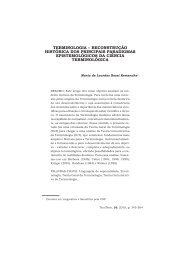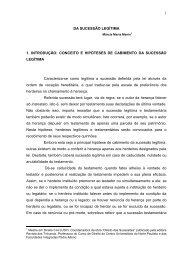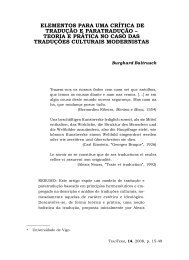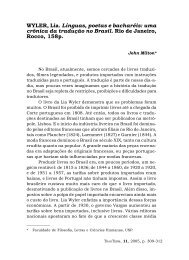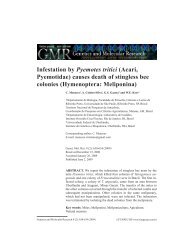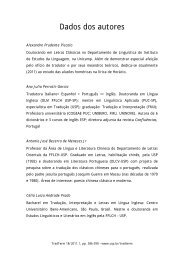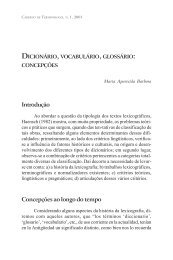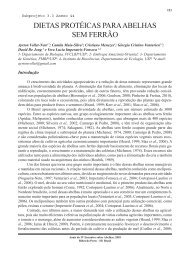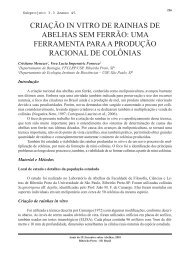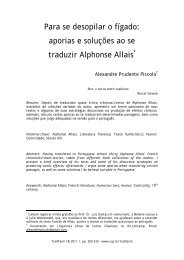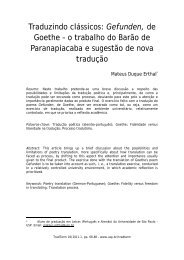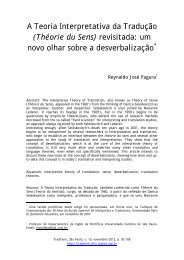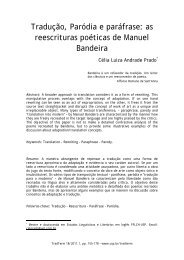Quantificação da produção do mel de Scaptotrigona aff. depilis
Quantificação da produção do mel de Scaptotrigona aff. depilis
Quantificação da produção do mel de Scaptotrigona aff. depilis
You also want an ePaper? Increase the reach of your titles
YUMPU automatically turns print PDFs into web optimized ePapers that Google loves.
<strong>Quantificação</strong> <strong>da</strong> <strong>produção</strong>... YAMAMOTO, D. Y. et al.<br />
quanti<strong>da</strong><strong>de</strong>s diferentes <strong>de</strong> <strong>mel</strong>. Ao produtor seria<br />
interessante o selecionamento genético <strong>da</strong>s colônias<br />
mais produtoras, aumentan<strong>do</strong> assim o lucro final com<br />
o <strong>mel</strong>iponário. Porém é necessário um estu<strong>do</strong> mais<br />
aprofun<strong>da</strong><strong>do</strong> <strong>da</strong> variabili<strong>da</strong><strong>de</strong> genética, ten<strong>do</strong> em vista<br />
a interpretação <strong>da</strong> história natural <strong>do</strong> grupo.<br />
Deve-se levar em consi<strong>de</strong>ração que o presente<br />
trabalho não fez nenhuma alteração na estrutura nas<br />
colméias, ou seja, não acrescentou nenhum módulo <strong>de</strong><br />
<strong>mel</strong>gueira em possíveis épocas <strong>de</strong> aumento <strong>de</strong><br />
biomassa <strong>da</strong> população <strong>da</strong>s colônias referi<strong>da</strong>s.<br />
Portanto, é possível retirar uma maior quanti<strong>da</strong><strong>de</strong> <strong>de</strong><br />
<strong>mel</strong> anualmente.<br />
A abelha Apis <strong>mel</strong>lifera produz<br />
aproxima<strong>da</strong>mente 25 kg <strong>de</strong> <strong>mel</strong> ao ano (ALMEIDA,<br />
MANRIQUE; SOARES, 2002). Apesar <strong>de</strong> essas<br />
abelhas produzirem uma quanti<strong>da</strong><strong>de</strong> <strong>de</strong> <strong>mel</strong><br />
numericamente maior que o <strong>mel</strong> <strong>do</strong>s <strong>mel</strong>iponíneos,<br />
observa-se que o preço <strong>de</strong> merca<strong>do</strong> <strong>de</strong> tal <strong>mel</strong> é muito<br />
inferior que <strong>de</strong> abelhas sem ferrão. Um quilograma <strong>de</strong><br />
<strong>mel</strong> <strong>de</strong> Apis <strong>mel</strong>lifera é vendi<strong>do</strong> <strong>de</strong> R$10,00 a<br />
R$15,00 reais, enquanto que um litro <strong>de</strong> <strong>mel</strong> <strong>de</strong><br />
<strong>mel</strong>iponíneos po<strong>de</strong> variar <strong>de</strong> R$ 20,00 a R$100,00<br />
reais no merca<strong>do</strong> (ALVES et al., 2005).<br />
Segun<strong>do</strong> ALVES et al. (2005), o custo <strong>de</strong><br />
implantação <strong>de</strong> um <strong>mel</strong>iponário é quase o <strong>do</strong>bro <strong>do</strong><br />
custo <strong>de</strong> um apiário. Porém o valor agrega<strong>do</strong> <strong>de</strong> tal<br />
<strong>mel</strong> no merca<strong>do</strong>, é muito maior <strong>de</strong>vi<strong>do</strong> ao seu sabor<br />
exótico e baixa oferta no merca<strong>do</strong>.<br />
ABSTRACT: The <strong>de</strong>velopment of stingless bee keeping in Brazil has been supported due to the differentiated<br />
flavor of this bee honey, which is used to heal several illnesses. Moreover, the handling of these stingless bees has provi<strong>de</strong>d the<br />
complementation of families income. In function of this <strong>de</strong>velopment, the present work had the aim of quantifying the<br />
<strong>Scaptotrigona</strong> <strong>aff</strong>. <strong>de</strong>pilis honey production. Two treatments were carried out: the period of the year influence on the honey<br />
production and the production of each colony honey. The analysis of the first test suggested that the period of the year <strong>do</strong>esn’t<br />
influence the honey production. The second treatment suggested that the colonies produce different amounts of honey,<br />
however analyzing them two by two, it was verified that only one analyzed pair is responsible for the differential production<br />
between the colonies, and the analysis of the others pairs indicates that the colonies produce the same amount of honey. There<br />
are evi<strong>de</strong>nces to <strong>aff</strong>irm that there is genetic variability in this species due to differential production; and that the production<br />
might be bigger if it the handling of such bees was practiced. The honey of stingless bees has a consi<strong>de</strong>rable value in<br />
commercialization and the production of <strong>Scaptotrigona</strong> <strong>aff</strong>. <strong>de</strong>pilis is comparable to the production of other species of bees.<br />
KEYWORDS: Meliponiculture. Honey. Stingless bee. <strong>Scaptotrigona</strong>. Production.<br />
REFERÊNCIAS<br />
ALMEIDA, R.; MANRIQUE, A. J.; SOARES, A. E. Egea. Seleção <strong>de</strong> <strong>mel</strong>horamento genético para aumentar a<br />
<strong>produção</strong> <strong>de</strong> <strong>mel</strong> e própolis. In: CONGRESSO BRASILEIRO DE APICULTURA, 11., 2000, Florianópolis.SC.<br />
Anais... Florianópolis: CBA, 2000. CD ROM.<br />
ALVES, M. L. T. M. F. N. Produção <strong>de</strong> pólen. Mensagem Doce – APACAME. v. 41, p.20-21. 1996.<br />
ALVES, R. M. O.; SOUZA, B. A.; CARVALHO, C. A. L.; JUSTINA, G. D.. Custo <strong>de</strong> <strong>produção</strong> <strong>de</strong> <strong>mel</strong>: uma<br />
proposta para abelhas africaniza<strong>da</strong>s e <strong>mel</strong>iponíneos 1 ed. Série <strong>mel</strong>iponicultura-nº 02. Cruz <strong>da</strong>s Almas:<br />
Universi<strong>da</strong><strong>de</strong> Fe<strong>de</strong>ral <strong>da</strong> Bahia/SEAGRI-BA. 2005. 14p.<br />
BREYER, H. F. E. 1996. Própolis - <strong>produção</strong> com Apis <strong>mel</strong>lifera L. In: CONGRESSO BRASILEIRO DE<br />
APICULTURA, 11, 1996, Teresina. Anais... Teresina: Confe<strong>de</strong>ração Brasileira <strong>de</strong> Apicultura, 1996. p. 193-197.<br />
CÁMARA, J. Q.; SOUSA, A. H. ; VASCONCELOS, W. E. ; FREITAS, R. S.; MAIA, P. H. S.; ALMEIDA, J. C.;<br />
MARACAJÁ, P. B. Estu<strong>do</strong>s <strong>de</strong> <strong>mel</strong>iponíneos, com ênfase a Melipona subniti<strong>da</strong> D. no município <strong>de</strong> Jan<strong>da</strong>íra, RN.<br />
Revista <strong>de</strong> Biologia e Ciências <strong>da</strong> Terra. V. 4, n. 1, p. 1-19. 2004.<br />
Biosci. J., Uberlândia, v. 23, Supplement 1, p. 89-93, Nov. 2007<br />
92



